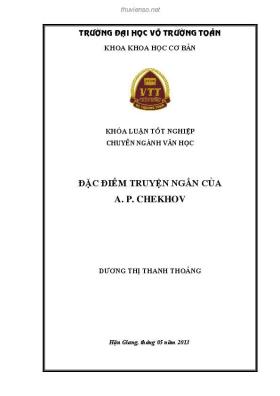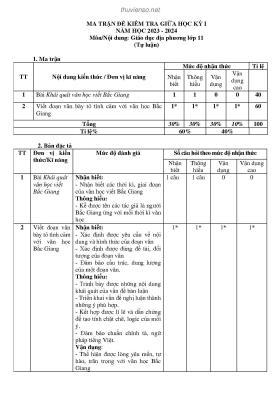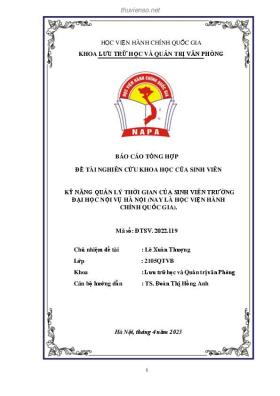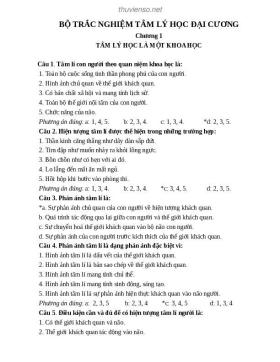
Mạng và viễn thông P9
Thông tin tài liệu:
Nội dung trích xuất từ tài liệu:
Mạng và viễn thông P9 Networks and Telecommunications: Design and Operation, Second Edition. Martin P. Clark Copyright © 1991, 1997 John Wiley & Sons Ltd ISBNs: 0-471-97346-7 (Hardback); 0-470-84158-3 (Electronic) Data Network Principles and Protocols We have described the binary form in which data are held by computer systems, and how such data are conveyed over digital line transmission systems, but we shall need to know more than this before we can design the sort ofdevices which can communicatesensibly with one another in somethingequivalent to human conversation.Inthischapter we shalldiscuss indetailthe conveyance of data between computer systems, the networks required, the and so-called ‘protocols’ they will need to ensure that they are communicating properly. In the second half of the chapter some practical data and computer network topologies and the equipment needed to support them are described.9.1 COMPUTER NETWORKS Between 1950 and 1970 computers were large and unwieldy, severely limited in their power and capabilities, and rather unreliable. Only the larger companies could afford them, and they were used for batch-processing scientific, business or financial data on a largescale. Data storageinthosedayswaslaborious,limitedincapacity,longin preparation, not at all easy to manage. Many storage mechanisms (e.g. paper tape and punched cards) were very labour-intensive; they were difficult to store, and prone to damage. Even magnetic tape, when it appeared, had its drawbacks; digging out some trivial information ‘buried’ in the middle of a long tape was a tedious business, and the tapes themselves had to be painstakingly protected against data corruption and loss caused by mechanical damage or nearby electrical and magnetic fields. Computing was for specialists. Computer centre staff lookedafterthe hardware, while software experts spent hours long improving computer their programmes, squeezing every last drop of ‘power’ out of the computers’ relatively restricted capacity. By the mid-1970s all this began to change, and very rapidly. Cheap semiconductors heralded the appearance of the microcomputer, which when packaged with the newly developed floppy diskette systems, opened a new era of cheap and widespread com- puting activity. Personal computers ( P G ) began to appear on almost every manager’s 177178 PRINCIPLES NETWORK DATA AND PROTOCOLS desk, and manyeven invaded peoples’ homes. Suddenly, computing waswithin reach of the masses, and the creation and storage of computer data was easy, cheap and fast. All sorts of individuals began to prepare their own isolated databases and to write computer programmes for small scale applications, but these individuals soon recog- nized the need to share information and to pass data between different computers. This could be done by transferring floppy diskettes from one machineto another, but as time went on that method on its own proved inadequate. Therewas a growing demand for more geographically widespread, rapid, voluminous data transfer. More recently, the demands of distributed processing computer networks comprising clients and servers have created a boom in demand for data networks. A very simple computer or data network consists of a computer linked to a piece of peripheral equipment, such as a printer. The link is necessary so that the data in the computer’s memory can be reproduced on paper. The problem is that a ‘wires-only’ direct connection of this nature is only suitable for very short connections, typically up .to about 20 metres. Beyond this range, some sort of line driver telecommunications technique must be used. A number of techniques are discussed here. A long distance point-to-pointconnectionmay be made using modems. A slightly more complex computer network might connect a number of computer terminals in outlying buildings back to a host (mainframe computer) in a specialized data centre. Another net ...
Tìm kiếm theo từ khóa liên quan:
Mạng viễn thông tín hiệu truyền dẫn vi mạch tuyến đường thông tin đường dài hệ thống mã số nhi phânTài liệu liên quan:
-
24 trang 358 1 0
-
Đề xuất xây dựng chiến lược quốc gia về an toàn không gian mạng
12 trang 203 0 0 -
Bài giảng Cơ sở truyền số liệu: Chương 4 - ĐH Bách Khoa Hà Nội
10 trang 115 0 0 -
Đồ án tốt nghiệp: Ứng dụng các DSP khả trình trong 3G (HV Công nghệ Bưu chính viễn thông)
35 trang 78 0 0 -
Giáo trình Kỹ thuật chuyển mạch - Học viện kỹ thuật quân sự
302 trang 69 1 0 -
29 trang 42 0 0
-
Cải tiến một số thuật toán heuristic giải bài toán clique lớn nhất
9 trang 39 0 0 -
Đồ án tốt nghiệp Đại học: Nghiên cứu kỹ thuật tối ưu hóa mạng chuyển tiếp Mimo
63 trang 37 0 0 -
Bài giảng Cơ sở truyền số liệu: Chương 1 - ĐH Bách Khoa Hà Nội
68 trang 35 0 0 -
Bài giảng Cơ sở truyền số liệu: Chương 0 - ĐH Bách Khoa Hà Nội
9 trang 33 0 0 -
Trường điện từ và kỹ thuật Anten
72 trang 32 0 0 -
95 trang 30 0 0
-
Tài liệu Lý thuyết mạch - Nguyễn Quốc Dinh
183 trang 30 0 0 -
Đồ án tốt nghiệp: Mạng nội hạt vô tuyến WLA (HV Công nghệ Bưu chính viễn thông)
36 trang 29 0 0 -
Mạng viễn thông- Lý thuyết thông tin
51 trang 29 0 0 -
Quyết định số 25/2007/QĐ-BKHCN
6 trang 29 0 0 -
Báo cáo đề tài Kỹ thuật chuyển mạch ATM
39 trang 29 0 0 -
Bài giảng Kỹ thuật thông tin số: Chương 1 - Giới thiệu chung
16 trang 28 0 0 -
Luận văn tốt nghiệp: Công nghệ nối mạng riêng ảo cho di động 3G (HV Công nghệ Bưu chính viễn thông)
113 trang 28 0 0 -
Giáo trình Kỹ thuật chuyển mạch - Học viện Kỹ thuật Quân sự
302 trang 28 0 0
 Timtailieu.net
Timtailieu.net 















